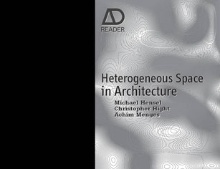Hensel, M., Hight, C., Menges, A. (eds.): 2009, Space Reader: Heterogeneous Space in Architecture, John Wiley and Sons, London. (ISBN 978-0470519424)
Edited by three leading figures in cutting-edge design, this reader brings space firmly back on to the agenda of contemporary architecture. Whereas space was one of the central tenets of 20th-century Modernism, in the last two decades the overriding preoccupation with digital technologies has shifted the focus to parametric geometries and complex surfaces. This emphasis on form and image has not been accompanied by similar advancements in the understandings of architectural space.
The Space Reader provides a highly pertinent and current understanding of space for a new generation of students and architects. It espouses an understanding of space that is heterogeneous, ordered through differential relationships between diverse systems leading to a multiplicity of atmospheres. As a generation of social geographers has argued, this type of complex space is characteristic of the metropolis, where multiple social and technological conditions are organically overlaid. The Space Reader attempts to lay the ground work for a similarly robust articulation of spatial complexity within architecture, and its relationship to today's built environment. With its emphasis on differentiation, heterogeneous space is pliant, flexible and highly relevant to the contemporary condition.


